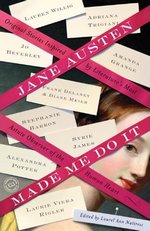 88 Austen-inspired stories were narrowed down to the Top Ten finalists last March in the Jane Austen Made Me Do It Short Story Contest. One lucky winner was chosen and announced yesterday. My congratulations go out to Brenna Aubrey, a talented new voice in Austenesque fiction.
88 Austen-inspired stories were narrowed down to the Top Ten finalists last March in the Jane Austen Made Me Do It Short Story Contest. One lucky winner was chosen and announced yesterday. My congratulations go out to Brenna Aubrey, a talented new voice in Austenesque fiction.
A contest to win one of four copies of Jane Austen Made Me Do It is open until midnight September 5, 2011. Leave a comment on the post announcing the opening of the JAMMDI website. An additional contest to win one of ten copies is also currently running on Goodreads, ending September 9, 2011, so make haste and head on over and leave a comment or a request to enter the contests.
Cheers
Laurel Ann
© 2007 – 2011 Laurel Ann Nattress, Austenprose
The count down is on!! EXCITING for all of you.
LikeLike
Was Jane Austen a Black Lesbian?
The first chapters in the novel Emma about Miss Harriet Smith seem to be talking about a emotional and physical friendship between the two young women. The scene of the Highbury spinsters sitting down for a supper of scalloped oysters sounds to me like Austen is amusing herself by talking dirty. When Harriet starts her sleepovers at Hartfield I see only one purpose.
But at the same time Emma plots her marriage with Mr. Elton, which suggests no emotional involvement. So the description of this friendship has to be understood on different levels as if Austen is addressing different sets of Harriet’s and Emma’s in different universes. This I have observed also in Mansfield Park were Austen’s chapters can be understood in many different ways, as she writes allegories. The persons in her novel represent values, institutions, and social categories.
Mrs. Weston cautions Mr. Knightley not to discuss his worries about the friendship with Emma’s sister, in order not to alarm her. Which suggests there is something alarming, less obvious to the casual onlooker; in that friendship. Lesbianism was not yet defined and most people probably had never heard of such a thing. This could be going on in front of them, or even they could have been participating in what we have learned to call lesbianism, and they did not know it. I believe that in Austen’s age lesbians were freer, and ‘spinsterhood’ was only terrible for people who were not spinsters, themselves.
But Austen has bigger fish to fry, and after saying her piece on lesbian relations, she moves on. As we are discussing Jane Austen and lesbianism, I take courage to introduce my own research: Was Jane Austen Black? Persons who have immersed themselves in one type of discrimination might perhaps be more willing to hear about other types of discrimination.
The novel Emma is Black History. This is strictly based on the many pen portraits, personal descriptions in Austen’s novels, which say that her personages are light brown or sallow, brown, very brown and black. Emma’s ‘Mr. Elton, black, spruce and smiling.’ Or Mr. Crawford: ‘absolutely plain, black and plain.’ And to make sure: his sister Mary is ‘brown with a lively black eye.’ The Bertram’s are ‘fair’ but not white. Emma who was somewhat bothered by Jane Fairfax’s pale complexion concludes that ‘she cannot be called fair.’ And that Fairfax had ‘just enough colour for beauty.’ Emma must have been very dark, with hazel eyes. Like Jane Austen herself with a ‘rich colour’ and a ‘brown complexion.’
Like Terry Castle, I get some very strange responses, if any at all. While the only response I’m waiting for is of a person to immediately reach for their own copies and confirm these facts. These description of people as brown or black are also found in her letters. And in Eliza Comtesse de Feuillides letters who boasts about how she ‘heightened the native brown of her complexion with a Tan.’
In this case the explanation cannot be: there were no Blacks. Or the black meant something else. Black meant something else because I’m talking about blackness, in Europe, and before 1848. Not the Hollywood, post –colonial, post Civil Rights movement, images of Blacks harboured by whites. The difference is of course the same as how a lesbian views lesbians compared how a non-lesbian views lesbians. Or how these two groups would countenance a lesbian Jane Austen. The question is why these descriptions are ignored. As scholars have researched every iota in Austen’s books or letters, they remain dead silent when it comes to these descriptions. Whites Austen called ‘Pink:’ like in Mrs Blount, ‘fat neck & Pink husband,’ in a letter to Cassandra.
So she had a reason to clearly make Marianne Dashwood ‘very brown.’ And write that Emma Watson was ‘very brown,’ but ‘some saw no fault and some no beauty.’ Or to some ‘her brown skin was the annihilation of every grace.’
Moving on, I feel she is addressing colorism among people of colour, and she proposes unity, as her Blacks are threatened to be written out of history. Which to me already has come to pass. Elizabeth Bennet who is ‘brown’ and ‘tanned’ is played by white actresses. As is black Mr. Elton played by a white actor, so we do not see that Austen is talking about race-mixing, that upsets both Mr. Elton and Mr. Knightley, which Austen was against herself.
So please, before you attack, read ‘Northanger Abbey’ about the ‘sallow’ or light brown Catherine Morland who gets more colour as she grows up and falls in love with Mr. Tilney, who was brown. The Tilney’s were ‘superior,’ and no explanation given by Austen. My research answers that question.
LikeLike